Long-term outcomes in heritable thoracic aortic disease
- PMID: 36312254
- PMCID: PMC9606219
- DOI: 10.3389/fcvm.2022.1009947
Long-term outcomes in heritable thoracic aortic disease
Abstract
Heritable aortic aneurysm is an increasingly recognized cause of morbidity and mortality. Whilst Marfan syndrome (MFS) is well-known, the clinical presentation and prognosis of more newly described genetic syndromes is less familiar to clinicians. There is a particular lack of knowledge regarding clinical outcomes for non-syndromal heritable aortic disease. This study investigated the presentation, clinical course and survival of patients with syndromal [Loeys-Dietz, aneurysm-osteoarthritis, and aneurysm-cerebral arteriopathy (ACTA2) syndrome] and non-syndromal heritable aortic disease in comparison to MFS. The study group includes 536 individuals (283 Marfan, 176 non-syndromal heritable aortopathy, 36 aneurysm-osteoarthritis, 32 Loeys-Dietz, and 9 ACTA2 aneurysm) enrolled in a longitudinal clinical follow-up between 1990 and 2022. Age at diagnosis differed between groups: Marfan = 22.0 ± 16.6; Loeys-Dietz = 29.6 ± 21.5; aneurysm-osteoarthritis = 36.4 ± 18.8; ACTA2 aneurysm = 43.4 ± 18.6; non-syndromal heritable aortopathy = 47.2 ± 16.6 years (p < 0.001). Aortic dissection was the presenting event in 8% individuals with Marfan compared to 27% with non-syndromal heritable aortopathy and 34% with Loeys-Dietz syndrome (p < 0.01). Mean follow-up duration for the group was 16.4 years (range 0.2-30 years) and 74 individuals died during follow-up (Marfan = 52, Loeys-Dietz = 6, aneurysm-osteoarthritis = 4, ACTA2 aneurysm = 1, heritable non-syndromal aortopathy = 11). At 10 years follow-up, actuarial mean survivals were: aneurysm-osteoarthritis = 77.5 ± 10.4%; Loeys-Dietz = 90.0 ± 6.8%; Marfan = 94.6 ± 1.4%; heritable non-syndromal aortopathy = 95.9 ± 2.1% (NS). There were 60 aortic dissections (24 Type A, 36 Type B) during follow-up. At 10 years, survival free of dissection was comparable between groups: aneurysm-osteoarthritis = 90.7 ± 6.4%; Loeys-Dietz = 94.4 ± 5.4%; Marfan = 96.1 ± 1.2%; heritable non-syndromal aortopathy = 93.9 ± 2.3%, with similar findings at 20 years. Prophylactic aortic surgery was a first event during follow-up for 196 individuals (ACTA2 aneurysm = 3; aneurysm-osteoarthritis = 10; Loeys-Dietz = 19; Marfan = 119; heritable non-syndromal aortopathy = 45). A second surgical intervention was required in 45 individuals and a third intervention in 21 individuals. At 10 years follow-up, survival free of surgery differed between groups: aneurysm-osteoarthritis = 68.5 ± 10.1%; Loeys-Dietz = 40.8 ± 11.2%; Marfan = 75.5 ± 2.7%; heritable non-syndromal aortopathy = 63.8 ± 4.7% (p < 0.001). At 20 years follow-up mean survival free of surgery was: aneurysm-osteoarthritis = 26.6 ± 14.7%; Loeys-Dietz = 9.1 ± 8.2%; Marfan = 57.2 ± 3.4%; heritable non-syndromal aortopathy = 41.6 ± 8.2% (p < 0.001). Diagnosis of newer syndromic and non-syndromal heritable aortopathies is delayed compared to MFS, with associated complications of presentation with aortic dissection. Survival of individuals enrolled in follow-up surveillance is comparable between different genetic aortopathies, however aortic dissections still occur and need for surgical intervention is high.
Keywords: Loeys-Dietz; Marfan; aneurysm; dissection; genetic; prognosis.
Copyright © 2022 Robertson, Bannon and Jeremy.
Conflict of interest statement
The authors declare that the research was conducted in the absence of any commercial or financial relationships that could be construed as a potential conflict of interest.
Figures
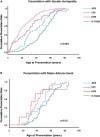
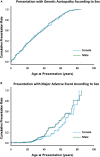
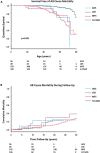

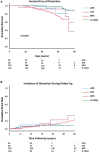
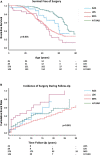
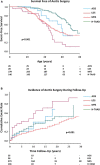
References
-
- Richards S, Aziz N, Bale S, Bick D, Das S, Gastier-Foster J, et al. Standards and guidelines for the interpretation of sequence variants: a joint consensus recommendation of the American college of medical genetics and genomics and the association for molecular pathhology. Genet Med. (2015) 17:405–24. 10.1038/gim.2015.30 - DOI - PMC - PubMed
LinkOut - more resources
Full Text Sources
Miscellaneous

